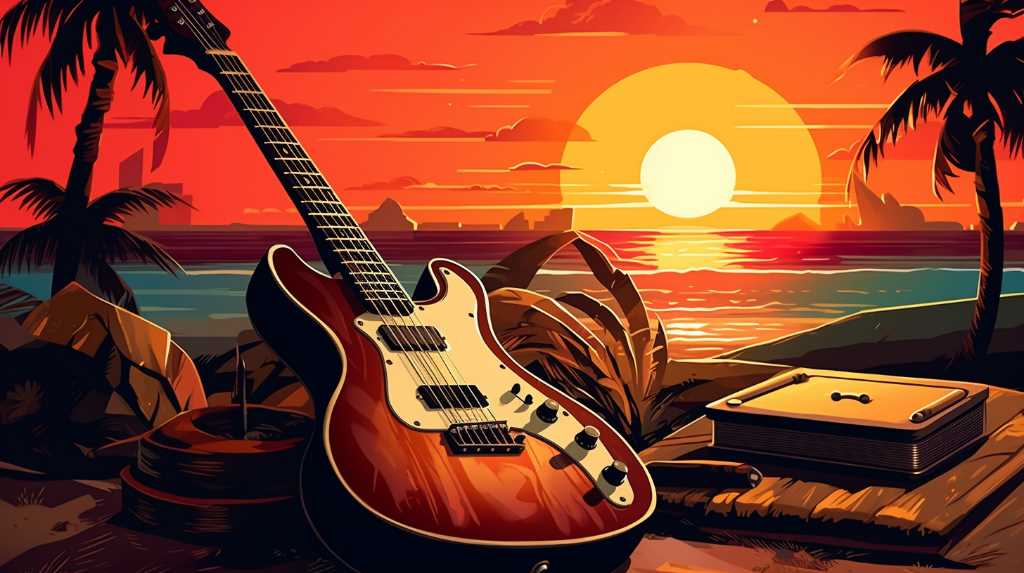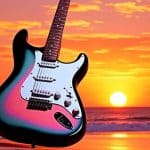
Surf rock is a type of music that’s all about the upbeat, beachy vibe. It came around in the early 1960s and quickly became the go-to sound for a good time near the ocean. To make a song in this style, it’s essential to know about the instruments that make surf rock unique. For example, the Fender Stratocaster guitar and amplifiers with a lot of reverb are key to getting that classic sound.
When you’re putting together a surf rock song, you need to think about how the music flows, much like waves in the sea. This means paying close attention to the melody and the beat to make sure they work together well. To make a surf rock track that feels both true to its roots and fresh today, you have to blend the old-school elements with new ideas.
Let’s break it down: if you want to create a surf rock song that captures the genre’s energetic and laid-back feel, you’ll need to use certain types of instruments and sounds. Specifically, you’ll want to look into guitars like the Fender Stratocaster and make sure your amplifiers can create a reverb effect that echoes the sound of the surf. The goal is to put together a tune that’s simple yet catchy, mirroring the rhythm of the waves and the beach lifestyle.
In the end, a good surf rock song should make listeners think of sunny beaches and good times, using familiar sounds in a fresh way that stands out. It’s about combining the classic surf rock style with your own twist to create something that’s both nostalgic and new.
Understanding Surf Rock Origins
Surf rock is a music style that started in the early 1960s in Southern California. It’s known for its loud guitar sounds and lively beats, which go well with the surfing lifestyle there. The music sounds like ocean waves and gives you the feeling of surfing.
Dick Dale, who played the guitar very fast, and The Ventures, known for their clear guitar sound, were important musicians in surf rock. They used a special effect called spring reverb to make the guitars sound like they are echoing, similar to the sound of water.
The drums and bass in surf rock are also fast and keep the music moving. This makes people think of warm weather and fun times.
Essential Instruments and Gear
To get the classic sound of surf rock, you’ll want to use a Fender Stratocaster or Jaguar guitar. These guitars have a special feature called a spring reverb, which makes the sound echo in a way that reminds you of the sea. This echoing effect is a big part of what makes surf rock music sound like it does. It’s also a good idea to use an amplifier that lets the guitar’s sharp and clear sound come through, and Fender amps are a popular choice for this.
The drums are really important in surf rock too. A normal drum set with a snare drum that has a very crisp sound is what you need, and adding bongo drums can make the beat even more exciting. When it comes to the bass guitar, a Fender Precision or Jazz Bass will give you the right kind of deep tone that supports the lively tunes of surf rock music.
Composing the Melody Line
To create a surf rock melody, start by picking instruments that sound like the sea.
Your melody should be simple and catchy, like a tune surfers can hum. Use the brighter sounds of the guitar, playing higher notes to make the melody stand out.
To get that surf music feel, try using scales like minor pentatonic or mixolydian. The melody should be clear and lively, fitting smoothly with the rhythm like a surfer on a wave.
When writing this melody, it’s important to keep it straightforward so it sticks in people’s heads. Avoid complex or overdone musical phrases. Explain that the reason for using certain scales is because they have the right vibe for surf music.
Capturing the Surf Beat
To get that classic surf music sound, which reminds you of ocean waves and sunny beaches, you need to start by setting a strong beat. This usually means using a 4/4 time signature, which is like the steady pulse of music. Make sure your snare drum sounds sharp and quick, like the fast crash of waves. Then, add electric guitars with lots of reverb, which is an effect that makes the guitar sound echoey and wet, like water. Don’t forget to bend the guitar strings with a whammy bar for extra effect. The music should feel fast and lively to make it exciting. The bass and drums need to work together well to really make you feel like you’re right there on a vintage beach.
When creating surf music, it’s key to give the guitar that echoed sound, and one way to do this is by using a guitar pedal that adds reverb. For example, the Boss FRV-1 ’63 Fender Reverb Pedal can make your guitar sound like it’s straight out of a 1960s surf track. This attention to detail in the instruments and effects used helps transport the listener to a different time and place, embodying the surf scene.
Always aim for a lively and energetic feel in your music to capture the fun of surfing. This kind of music isn’t just about the notes and rhythms; it’s about creating a whole mood that takes people to the beach, no matter where they are.
Mixing and Production Techniques
In surf rock music, using the right mixing methods is key to getting that classic sound with lots of reverb that makes you feel upbeat. It’s important to make sure that the loud, sharp guitar sounds work well with the drums and bass, so everything is clear when you listen. You should use reverb that echoes but doesn’t last too long, so the songs still feel fast and exciting.
When you’re controlling the volume, it’s best to do it gently. This keeps the music’s lively feel but stops any sudden loud parts from being too jarring. By spreading the guitar sounds to the left and right in the mix, you give listeners a sense of openness, like being at the sea. Adjusting the sound frequencies (EQ) lets the music have a bright, happy vibe without sounding too harsh. This takes the music from just being recorded to giving you the full beach experience.
Let’s break this down with some specifics. For example, guitar reverb can be achieved with a pedal like the Boss FRV-1 ’63 Fender Reverb or a plugin such as the Waves Abbey Road Reverb Plates for that authentic surf rock echo. Compressors like the FMR Audio RNC1773 can handle volume dynamics without squashing the life out of the music. And for EQ, the SSL E-Series Channel Strip plugin is great for making sure your guitars have that sunny sparkle without any unpleasant sharpness.
With these tools and techniques, you can create a mix that really captures the energy and vibe of surf rock.
Conclusion
To wrap things up, making a surf rock song for a soundtrack means you have to be very careful to get the classic sound of the genre right while also adding in unique instrumental touches. It’s important to create catchy tunes that stick in people’s heads, and you’ve got to have that typical surf rhythm. When mixing and producing the song, it’s key to use plenty of reverb and make sure the lively beats and the guitar’s twang are balanced just right. This way you really capture the fun and energetic vibe that surf rock is all about.
For example, if you’re trying to get that surf rock sound, you might want to use a Fender Stratocaster guitar because it has the kind of twangy tone that’s perfect for the genre. And don’t forget about the reverb – an effect like the Fender Reverb Tank can help create the spacious sound that’s a hallmark of surf music. These specifics are important because they help anyone trying to recreate this style know exactly what tools will get them the desired effect.








